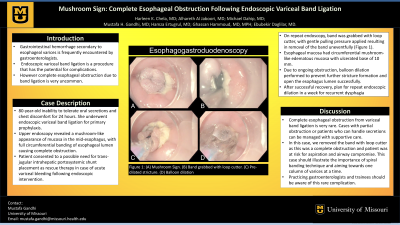Back


Poster Session B - Monday Morning
Category: Endoscopy Video Forum
B0194 - Mushroom Sign: Complete Esophageal Obstruction Following Endoscopic Variceal Band Ligation
Monday, October 24, 2022
10:00 AM – 12:00 PM ET
Location: Crown Ballroom

Has Audio

Mustafa H. Gandhi, MD
University of Missouri-Columbia
Columbia, MO
Presenting Author(s)
Award: Presidential Poster Award
Harleen K. Chela, MD1, Alhareth Al Juboori, MD2, Michael Dahip, MD1, Mustafa H. Gandhi, MD1, Hamza Ertugrul, MD3, Ghassan Hammoud, MD, MPH4, Ebubekir Daglilar, MD3
1University of Missouri-Columbia, Columbia, MO; 2University of Missouri-Columbia, Scottsdale, AZ; 3University of Missouri, Columbia, MO; 4University of Missouri Health Care, Columbia, MO
Introduction: Gastrointestinal hemorrhage secondary to esophageal varices is frequently encountered by gastroenterologists. Endoscopic variceal band ligation is a procedure that has potential for complications. However complete esophageal obstruction due to band ligation is very uncommon.
Case Description/Methods: An 80-year-old female patient transferred to our hospital with complaints of inability to tolerate oral secretions and chest discomfort. 24 hours prior to transfer, she underwent endoscopic variceal band ligation and three bands placed for primary prophylaxis. CT chest showed esophagus was dilated with fluid retention. and there was 1cm mass-like lesion in distal esophagus. Upper endoscopy was performed and revealed a mushroom-like appearance of mucosa in mid-esophagus, with a full circumferential banding of the esophagus lumen causing complete esophageal obstruction. Underlying band was seen. Following initial endoscopic exam, we discussed risk and benefits of band removal. Hepatology and interventional radiology were consulted and patient was consented for a possible need for transjugular intrahepatic portosystemic shunt placement as a rescue therapy in case of an acute variceal bleeding following endoscopic intervention. Repeat endoscopy was performed using the distal attachment cap, and band was grabbed with loop cutter, and gentle pulling pressure applied resulting removal of the band uneventfully (d). Subsequent endoscopic examination showed esophageal mucosa had circumferential mushroom-like edematous mucosa with ulcerated base in 10 mm length at 30 cm from incisors (e). Due to ongoing obstruction, we performed balloon dilation (8-10mm) to prevent further stricture formation and open the esophagus lumen (f). There was no post-procedure bleeding and scope was easily traversed the stenosis. Patient recovered well post-procedure and discharged home next day. A week later, patient had ongoing dysphagia and repeat endoscopy was scheduled for dilation.
Discussion: Complete esophageal obstruction from variceal band ligation is very rare. Cases with partial obstruction or patients who can handle secretions can be managed with supportive care. In this case, we removed the band with loop cutter as this was a complete obstruction and patient was at risk for aspiration and airway compromise. This case should illustrate the importance of spiral banding technique and aiming towards one column of varices at a time. Practicing gastroenterologists and trainees should be aware of this rare complication.
Disclosures:
Harleen K. Chela, MD1, Alhareth Al Juboori, MD2, Michael Dahip, MD1, Mustafa H. Gandhi, MD1, Hamza Ertugrul, MD3, Ghassan Hammoud, MD, MPH4, Ebubekir Daglilar, MD3. B0194 - Mushroom Sign: Complete Esophageal Obstruction Following Endoscopic Variceal Band Ligation, ACG 2022 Annual Scientific Meeting Abstracts. Charlotte, NC: American College of Gastroenterology.
Harleen K. Chela, MD1, Alhareth Al Juboori, MD2, Michael Dahip, MD1, Mustafa H. Gandhi, MD1, Hamza Ertugrul, MD3, Ghassan Hammoud, MD, MPH4, Ebubekir Daglilar, MD3
1University of Missouri-Columbia, Columbia, MO; 2University of Missouri-Columbia, Scottsdale, AZ; 3University of Missouri, Columbia, MO; 4University of Missouri Health Care, Columbia, MO
Introduction: Gastrointestinal hemorrhage secondary to esophageal varices is frequently encountered by gastroenterologists. Endoscopic variceal band ligation is a procedure that has potential for complications. However complete esophageal obstruction due to band ligation is very uncommon.
Case Description/Methods: An 80-year-old female patient transferred to our hospital with complaints of inability to tolerate oral secretions and chest discomfort. 24 hours prior to transfer, she underwent endoscopic variceal band ligation and three bands placed for primary prophylaxis. CT chest showed esophagus was dilated with fluid retention. and there was 1cm mass-like lesion in distal esophagus. Upper endoscopy was performed and revealed a mushroom-like appearance of mucosa in mid-esophagus, with a full circumferential banding of the esophagus lumen causing complete esophageal obstruction. Underlying band was seen. Following initial endoscopic exam, we discussed risk and benefits of band removal. Hepatology and interventional radiology were consulted and patient was consented for a possible need for transjugular intrahepatic portosystemic shunt placement as a rescue therapy in case of an acute variceal bleeding following endoscopic intervention. Repeat endoscopy was performed using the distal attachment cap, and band was grabbed with loop cutter, and gentle pulling pressure applied resulting removal of the band uneventfully (d). Subsequent endoscopic examination showed esophageal mucosa had circumferential mushroom-like edematous mucosa with ulcerated base in 10 mm length at 30 cm from incisors (e). Due to ongoing obstruction, we performed balloon dilation (8-10mm) to prevent further stricture formation and open the esophagus lumen (f). There was no post-procedure bleeding and scope was easily traversed the stenosis. Patient recovered well post-procedure and discharged home next day. A week later, patient had ongoing dysphagia and repeat endoscopy was scheduled for dilation.
Discussion: Complete esophageal obstruction from variceal band ligation is very rare. Cases with partial obstruction or patients who can handle secretions can be managed with supportive care. In this case, we removed the band with loop cutter as this was a complete obstruction and patient was at risk for aspiration and airway compromise. This case should illustrate the importance of spiral banding technique and aiming towards one column of varices at a time. Practicing gastroenterologists and trainees should be aware of this rare complication.
Disclosures:
Harleen Chela indicated no relevant financial relationships.
Alhareth Al Juboori indicated no relevant financial relationships.
Michael Dahip indicated no relevant financial relationships.
Mustafa Gandhi indicated no relevant financial relationships.
Hamza Ertugrul indicated no relevant financial relationships.
Ghassan Hammoud indicated no relevant financial relationships.
Ebubekir Daglilar indicated no relevant financial relationships.
Harleen K. Chela, MD1, Alhareth Al Juboori, MD2, Michael Dahip, MD1, Mustafa H. Gandhi, MD1, Hamza Ertugrul, MD3, Ghassan Hammoud, MD, MPH4, Ebubekir Daglilar, MD3. B0194 - Mushroom Sign: Complete Esophageal Obstruction Following Endoscopic Variceal Band Ligation, ACG 2022 Annual Scientific Meeting Abstracts. Charlotte, NC: American College of Gastroenterology.

